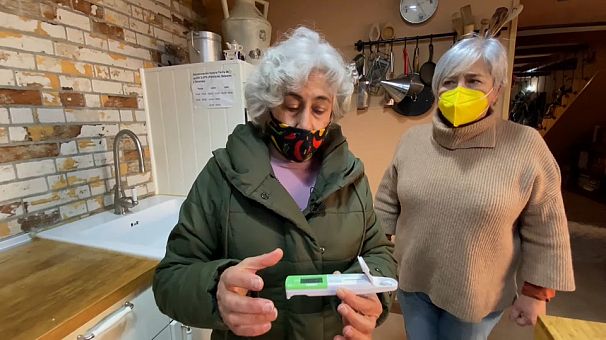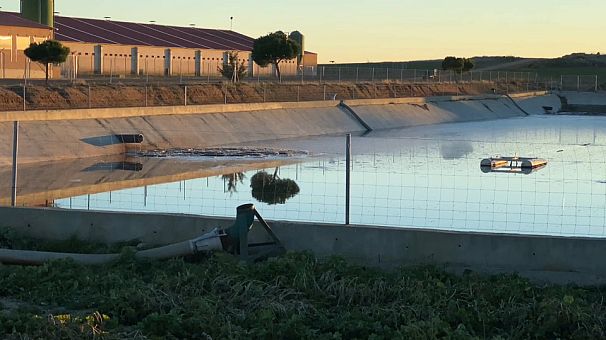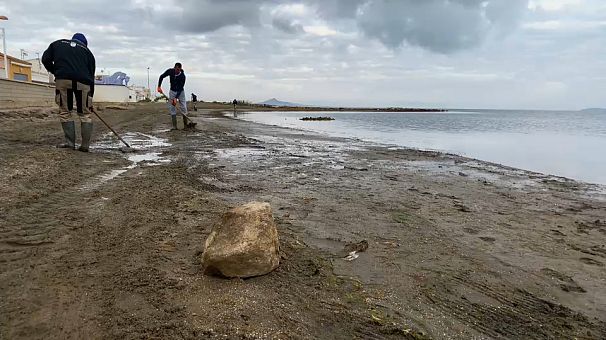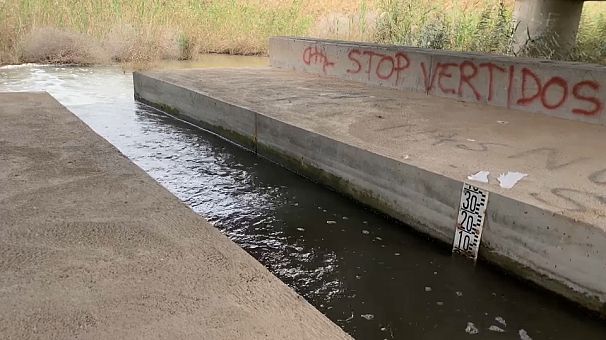In this episode of Witness, Euronews' Monica Pinna travels to Zamora in Spain to investigate how human activity is polluting the water supply, threatening entire populations and ecosystems.
How clean is Europe's water? It's estimated around half of Europe's rivers, lakes and coastal waters contain dangerous substances. In Spain, the pollution from pig farms poses a threat to both people and local ecosystems.
Zamora: home to contaminated water
Zamora in Spain is just one of several provinces where the tap water is contaminated. Emilia Román was born here and in the past year she has travelled around the region to regularly measure the quantity of nitrates in drinking water and groundwater sources.
I accompanied her to the village of Santovenia. She had come with a nitrate metre to check the tap water of her friend, Sonsoles. Emilia is a member of a residents’ network created by Greenpeace to monitor water quality in Spain’s rural areas.
“We use this little tool to make three measurements," Emilia told me.
"You put tap water here and then you read the result,” she explained.
The three measurements on Sonsoles’ tap water were all above the legal threshold. Emilia and Sonsoles are worried because high levels of nitrates can increase the risk of miscarriage, birth defects and even cancer. They are angry, because they know what and who is to blame.
“It’s very clear what is contaminating the water. It’s intensive farming and those who are dumping waste in the fields,” said Sonsoles. “Nitrates coming from manure filter into groundwater and pollute it.”
Mega Pig farms: public enemy number one
The water contamination problem has become so bad that it's become a national scandal. Locals have accused the authorities of not doing enough and regularly take to the streets to protest against the large pig farms.
“The problem with the mega farms is that they are invading us. There are 600,000 pigs in Zamora. This is unbearable. It’s an unsustainable industry.” said Luís de Nicolás Latorre, a spokesperson of Tierra de Alba, residents’ association.
The region of Castilla y León is in the top twenty for number of pigs in Europe. Spain is also Europe’s biggest pig meat exporter. In some areas, pigs outnumber residents.
No farmers agreed to talk to us. I took to the road with Greenpeace to see how pig slurry is disposed.
The farms can be spotted easily across Zamora. We stopped next to one of them.
“The manure produced by these animals is collected in these tanks and then spread all over the neighbouring fields. Explains Luís Ferreirim, Head of Agriculture Campaign for Greenpeace Spain. “When the ground can’t absorb any more, excrement leaks into the groundwater and contaminates it.”
While this practice is common and legal in Spain, environmental campaigners say the real problem is its scale.
“The laws are very lax” , continued Luís. “They allow authorisation without a global vision of what’s happening on the ground.”
In some of Spain’s main pig farming regions groundwater nitrate levels have been found to be up to four times higher than the legal threshold of 50 mg per litre. While this is not so common, lower illegal levels are widespread. Greenpeace told me that according to official data, 23% of Spanish groundwater is contaminated by nitrates, as well as 22% of surface water.
According to Greenpeace, this is just the tip of the iceberg. The environmental group got residents involved in the water monitoring to increase the number and frequency of measurements. They say the results are worrying.
“In 2000, around 60 municipalities were affected by nitrate pollution in the region of Castilla y León. Currently there are more than 700. This doesn’t concern only this region. Catalonia has 40 percent of its underground aquifers totally contaminated by nitrates,” Luís told Euronews.
Brussels has referred Spain to the European Court of Justice for failing to tackle nitrate pollution. Intensive agriculture, like the rearing of livestock, is blamed. The starkest example of which is the eco-disaster at Mar Menor.
Mar Menor: fertilised to death
Almost every morning the beach of Los Nietos is raked thoroughly to prevent too much algae rotting on the shore. But in summer this task becomes almost impossible. Algae grows uncontrollably, nourished by nitrates from farm fertilisers.
This process, called eutrophication, led to two catastrophic events in 2019 and last year. In both cases, tonnes of dead fish washed ashore, shocking the world.
I spent a day with Pedro, an environmentalist, and Ramón, the president of a residents’ group, to better understand how this happened.
“Intensive agriculture is practiced all around Mar Menor. Nutrients leak into the lagoon.” Pedro explained.
“These fertilisers destabilise the ecosystem and produce eutrophication - excessive algae growth. The sea turns into 'green soup' in the summer and at times kills the fish because of a lack of oxygen in the water, as we have seen. No solution has been found yet, because the solution is inland.”
We didn’t have to go very far to find Campo de Cartagena, 60,000 hectares of intensive farmed land around the lagoon. According to Ramón, irrigation is the main cause behind Mar Menor’s collapse.
“This kind of intensive agriculture has put an end to terraced fields. This area has become a huge plane that leans towards Mar Menor. Intense rainfall causes huge erosion and takes soil and fertilisers to Mar Menor,” Ramón said.
The representative of irrigation farmers in Campo de Cartagena told me agriculture is not the only factor to blame and insisted most farmers have switched to sustainable production methods.
“Well-managed intensive agriculture doesn’t cause any problems.” said Manuel Martínez Madrid, President of the Campo de Cartagena irrigation farmers’ association. “There‘s no reason to believe it contributes to the poor state of Mar Menor. We use less than half the water that the Food and Agriculture Organization recommends, and much less fertiliser than the FAO recommends. We use the least amount of fertilisers in the world.”
Nevertheless, data show tonnes of nitrates go into the lagoon every day. Associations and scientists have been calling on local and national authorities for years to save the lagoon. They complain that their voice is systematically ignored.
The local conservative administration gave me a long list of measures they are implementing but pinned some of the responsibility on Madrid’s ruling left-wing coalition.
The reality, however, is that Mar Menor is dying. Scientists say it’s still possible to save it, but the longer that takes, the more irreversible the damage will be.















